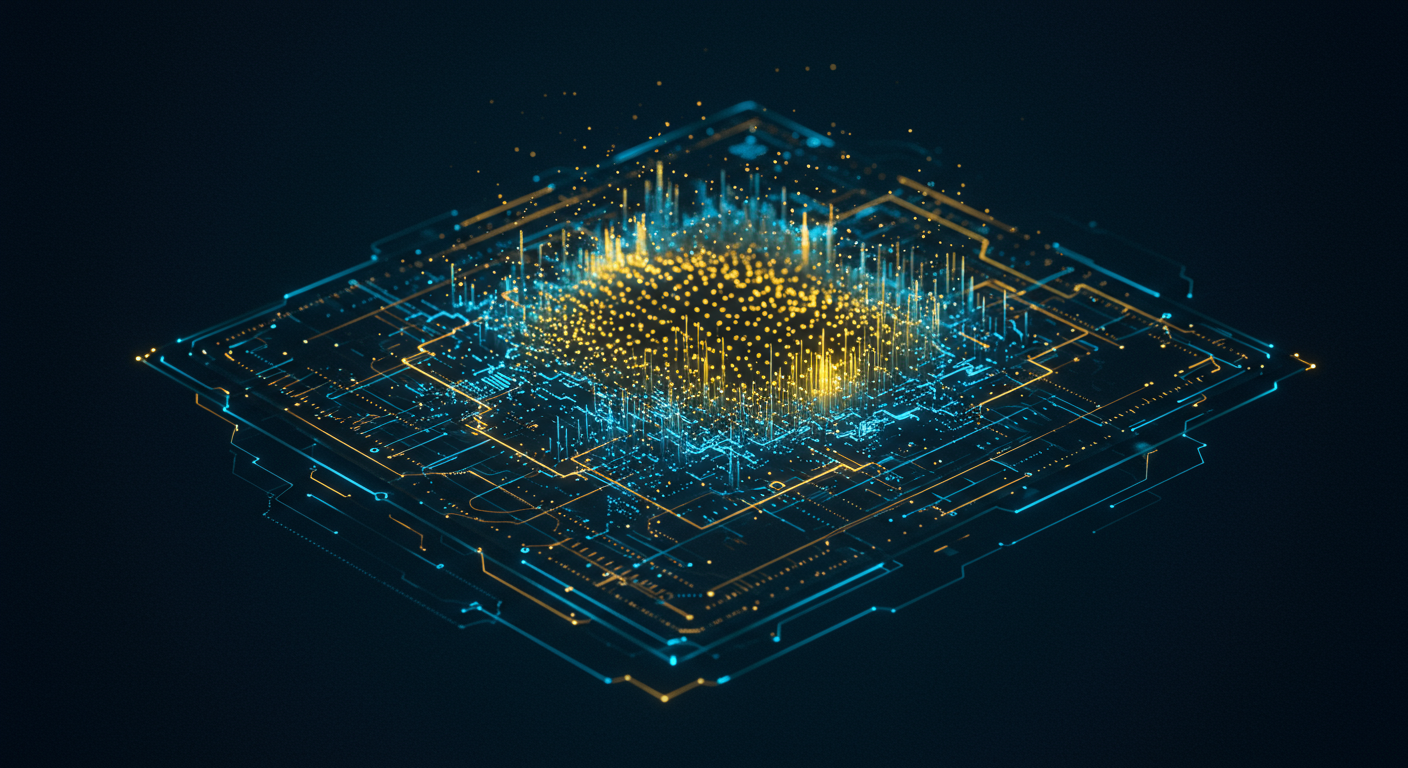AI-Powered Location Intelligence: Transforming Geospatial Analysis with Amazon Bedrock

Unlocking Location Intelligence: How Amazon Bedrock is Revolutionizing Geospatial Analysis
Location intelligence (LI) is no longer just about maps; it's about understanding the why behind the where, transforming industries with data-driven insights.
What is Location Intelligence?
Location Intelligence leverages Geographic Information Systems (GIS) data with business analytics to provide context and insight. Think of it as understanding customer behavior based on location, optimizing supply chains using real-time traffic data, or predicting disease outbreaks based on environmental factors. From urban planning to retail strategy, the applications are vast.Amazon Bedrock's AI Revolution
Amazon Bedrock is a fully managed service that offers a choice of high-performing foundation models (FMs) from leading AI companies. Its potential to revolutionize AI applications, including geospatial analysis, is immense.The Synergy
The true magic happens when AI meets geospatial data. Imagine feeding satellite imagery into Amazon Bedrock to automatically identify deforestation patterns, or using AI to predict traffic congestion based on historical data and real-time events. The possibilities are almost limitless. Here are a few use cases:- Real Estate: Identify optimal locations for new developments based on demographic data, zoning regulations, and market trends.
- Logistics: Optimize delivery routes in real-time, accounting for traffic, weather, and other dynamic factors.
- Environmental Monitoring: Track deforestation, pollution, and other environmental changes using satellite imagery analysis.
- Disaster Response: Predict and respond to natural disasters more effectively by analyzing geospatial data and social media feeds.
Addressing Misconceptions
"AI in GIS is just a gimmick."
Not so! AI algorithms can process vast amounts of geospatial data much faster and more accurately than traditional methods. The real value lies in uncovering patterns and insights that would otherwise remain hidden. For example, AI can analyze social media data to detect emerging trends or sentiments in specific geographic areas, providing businesses with valuable real-time insights.
Location intelligence is moving beyond static maps and towards predictive, data-driven insights, and platforms like Amazon Bedrock are at the forefront of this revolution. Curious to see which other AI tools are leading the charge? Check out our top 100 AI tools for more.
Location, location, location - it's not just about real estate anymore; it's about AI-powered geospatial analysis.
The Power of Place: Key Geospatial Use Cases Enhanced by Amazon Bedrock
Amazon Bedrock allows developers to build and scale AI applications using foundation models. Its capabilities extend to geospatial analysis, unlocking insights previously hidden in location data. Let's explore some key applications.
Smart City Planning
Imagine cities that breathe efficiency. With Amazon Bedrock, that vision edges closer:
- Traffic Optimization: Analyzing real-time traffic patterns to dynamically adjust traffic light timings and reduce congestion. Think Waze, but with a city-wide brain.
- Urban Sprawl Prediction: Modeling urban growth and its impact on infrastructure and environment. This lets planners anticipate and mitigate negative consequences.
- Resource Allocation: Optimizing placement of emergency services, public transportation, and other resources based on population density and predicted needs.
Environmental Monitoring
Our planet whispers secrets in geospatial data; AI can amplify them:
- Deforestation Tracking: Monitoring forest cover changes using satellite imagery and AI to detect illegal logging and deforestation hotspots.
- Pollution Detection: Identifying pollution sources and patterns from air and water quality data.
- Climate Change Impact Assessment: Modeling the effects of rising sea levels, extreme weather events, and other climate change impacts on specific locations.
Disaster Response
In times of crisis, every second counts:
- Real-time Damage Assessment: Analyzing satellite and aerial imagery to quickly assess damage after earthquakes, hurricanes, or other disasters.
- Evacuation Planning: Optimizing evacuation routes based on real-time conditions and predicted disaster paths.
- Resource Deployment: Allocating emergency resources – personnel, equipment, and supplies – to the areas of greatest need with speed and precision.
Agriculture
AI is helping farmers cultivate smarter crops:
- Crop Yield Prediction: Forecasting yields based on weather patterns, soil conditions, and other geospatial data.
- Precision Farming: Optimizing irrigation, fertilization, and pest control for specific areas within a field. This is about giving each plant exactly what it needs.
- Disease Detection: Identifying early signs of crop diseases from aerial imagery.
Supply Chain Optimization
Getting things from A to B just got a whole lot smarter:
- Route Planning: Finding the most efficient delivery routes considering traffic, weather, and other real-time factors.
- Warehouse Location: Determining optimal locations for warehouses based on proximity to suppliers and customers.
- Delivery Efficiency: Improving the speed and reliability of deliveries by optimizing inventory management and distribution strategies.
Here's how AI is unlocking a new era of geospatial understanding.
From Pixels to Insights: Integrating Geospatial Data with Bedrock's AI Models
Forget static maps; we're talking dynamic, AI-powered location intelligence, and Amazon Bedrock is a key. Bedrock provides access to various AI models for geospatial tasks, revolutionizing how we analyze everything from satellite imagery to LiDAR data. It streamlines deploying and scaling foundation models for geospatial uses.
Wrangling Geospatial Data
The first step? Getting your data into a usable format.- Raster Data: Think satellite images. These often require preprocessing to correct for atmospheric effects and geometric distortions.
- Vector Data: Points, lines, and polygons representing features like roads or buildings. Prepare by cleaning attributes, removing duplicates and fixing geometries.
Bedrock's AI Arsenal
Bedrock boasts a range of AI models fit for geospatial tasks:- Image Recognition Models: Identifying objects in satellite imagery (e.g., vehicles, buildings, deforestation).
- Object Detection Models: Accurately locating and classifying features (e.g., identifying and counting trees in a forest).
- Time-Series Analysis: Monitoring land use changes over time, predicting urban growth, analyzing environmental change.
Unlocking Insights
AI turns raw data into actionable intelligence. For example:- Satellite Imagery Analysis: Imagine automatically detecting illegal logging activities in a rainforest or assessing crop health across vast agricultural areas.
- LiDAR Data Processing: Now picture generating high-resolution 3D models for urban planning or disaster response.
- Data Mining Automation: Using Software Developer Tools with Bedrock to pull, clean and automate data pulls.
Overcoming the Challenges
This isn't always easy street; data volume, quality, and computational resources need careful management.- Data Volume: Large geospatial datasets demand scalable infrastructure.
- Data Quality: Accurate training data is critical for reliable AI model performance.
- Computational Resources: Training complex models requires serious processing power. Consider exploring cloud-based AI options for cost-effective solutions.
Geospatial analysis just got a whole lot smarter, thanks to AI.
Building a Geographically Intelligent Application: A Practical Workflow with Amazon Bedrock

Ready to harness the power of AI for location intelligence? Here’s a step-by-step workflow using Amazon Bedrock, designed for professionals eager to build geographically intelligent applications. Amazon Bedrock provides a selection of high-performing foundation models (FMs) from leading AI companies, accessible through a single API.
- Data Acquisition and Preprocessing:
- Gather geospatial data from sources like satellite imagery, GIS datasets, or APIs.
- Store this data in AWS S3. S3 is an object storage service that provides scalability, data availability, security, and performance.
- Preprocess the data using tools like GDAL or rasterio.
- Model Selection and Training (if necessary):
- Choose a suitable foundation model in Amazon Bedrock for your task. Consider models specialized in image recognition (for satellite imagery), natural language processing (for location-based text data), or time series analysis.
- Fine-tune the model using SageMaker, if needed, for enhanced performance on your specific geospatial data. SageMaker is a fully managed service that provides every developer and data scientist with the ability to build, train, and deploy machine learning (ML) models quickly.
- Deployment and Scaling:
- Deploy the trained model using AWS Lambda. Lambda lets you run code without provisioning or managing servers.
- Utilize API Gateway to create a secure and scalable API endpoint for your application.
- Monitoring and Evaluation:
- Monitor your application's performance with CloudWatch.
- Implement feedback loops to continuously improve your model’s accuracy.
python import boto3 def lambda_handler(event, context): # Load model and process data here return { 'statusCode': 200, 'body': 'Analysis Complete!' }
AI-powered location intelligence is revolutionizing how we understand and interact with our world – go forth and build something brilliant! Explore our Prompt Library for more inspiration.
AI is redrawing the world, pixel by pixel, with location intelligence more powerful than ever before.
Geospatial Data Fusion and Prediction
Imagine merging real-time traffic data with crime statistics and social media sentiment – that's geospatial data fusion in action.> Like predicting flash floods by analyzing rainfall patterns alongside drainage maps using AI. By combining diverse data sources, we can create detailed, dynamic models for predictive analytics of location-based events. Predictive analytics are helpful in areas from retail site selection to emergency response planning.Optimizing Space with Smarts
AI can now optimize the placement of everything from cell towers to emergency services, maximizing coverage and minimizing response times. AI spatial optimization efficiently analyzes spatial data to solve complex location-based problems. It's all about identifying patterns and relationships that humans might miss, leading to more efficient resource allocation.The Future is Edge and Explainable

Edge computing is moving processing power closer to the data source, enabling real-time geospatial analysis. We are talking immediate insights from drone imagery or sensor networks, reducing latency and improving decision-making. Crucially, explainable AI (XAI) provides transparency in these decisions, ensuring accountability and trust, particularly important in sensitive applications like urban planning.
- IoT Integration: Imagine smart cities where every device is a data point, feeding into a central AI that optimizes traffic flow, resource allocation, and public safety.
- Blockchain Verification: Secure and transparent tracking of assets and land ownership, preventing fraud and ensuring data integrity.
Here's how we can tackle the trickiest aspects of geospatial AI, like using Amazon Bedrock, the service that offers a choice of high-performing foundation models (FMs) from leading AI companies.
Overcoming the Hurdles: Addressing Challenges and Best Practices for Geospatial AI Projects
Implementing geospatial AI is not always a walk in the park; here are some common challenges and how we can overcome them:
Data Privacy and Security
"With great data comes great responsibility," especially when dealing with sensitive location information.
- Challenge: Geospatial data often contains personally identifiable information (PII), raising concerns about data breaches and regulatory compliance (e.g., GDPR).
- Best Practices:
- Implement robust encryption and access controls.
- Anonymize or pseudonymize data where possible.
- Comply with relevant data privacy regulations.
- Consider using differential privacy techniques to add noise to datasets.
- For Privacy-Conscious Users data security is key, so choosing the right AI tools can help to keep information safe.
Algorithmic Bias
- Challenge: Datasets used to train geospatial AI models may contain biases, leading to discriminatory outcomes. Think about how Design AI Tools can sometimes perpetuate existing biases if not carefully implemented.
- Best Practices:
- Carefully audit training data for biases.
- Use fairness-aware algorithms.
- Regularly monitor models for discriminatory outcomes.
- Employ techniques like adversarial debiasing to mitigate bias.
Scalability and Cost Optimization
- Challenge: Processing large geospatial datasets requires significant computing resources and can be expensive, especially when working with cloud platforms like AWS.
- Best Practices:
- Use scalable cloud infrastructure.
- Optimize algorithms for performance.
- Employ cost-effective AI services, such as using serverless inference.
- Explore Cost Optimization AWS AI tools to keep your AWS AI costs in check.
Ethical Considerations
- Challenge: The use of geospatial AI can raise ethical concerns, such as the potential for surveillance, unfair targeting, or displacement of communities.
- Best Practices:
- Adopt a code of ethics for geospatial AI development.
- Engage stakeholders in discussions about ethical considerations.
- Ensure transparency and accountability in AI decision-making.
- Prioritize fairness, beneficence, and non-maleficence in AI applications.
The Geospatial AI Horizon: Where Amazon Bedrock is Taking Location Intelligence
Geospatial analysis is entering a new era, propelled by the power of AI, with Amazon Bedrock at the forefront, providing the foundation for building and scaling generative AI applications.
Unleashing the Power of Location Data
Amazon Bedrock provides seamless access to a spectrum of foundational models, making advanced geospatial analysis more accessible than ever. Here’s how:
- Enhanced Accuracy: AI algorithms sift through vast datasets, correcting errors and identifying patterns with unparalleled precision.
- Faster Insights: Automating repetitive tasks frees up analysts to focus on strategic decision-making, shrinking project timelines considerably.
- Predictive Analytics: By analyzing historical trends and real-time data, anticipate future events and trends with greater confidence. For example, predicting traffic congestion patterns to optimize delivery routes.
- Scalability: Easily handle massive datasets and complex analyses that were previously impractical.
The Future is Now: Geospatial AI Applications
The future of geospatial AI is incredibly promising. Imagine these scenarios:
- Smart Cities: AI-powered urban planning optimizes resource allocation, improves infrastructure management, and enhances citizen experiences.
- Precision Agriculture: Farmers use AI to monitor crop health, optimize irrigation, and reduce pesticide use, leading to increased yields and sustainability.
- Disaster Response: First responders can use AI to rapidly assess damage, identify affected populations, and coordinate relief efforts, saving lives and minimizing impact.
Your Journey into Geospatial AI
Ready to explore this exciting frontier? The Amazon Bedrock AI roadmap is constantly evolving, offering new tools and capabilities for geospatial analysis. Don't just stand by – dive in and start experimenting! To learn more about getting started with Amazon Bedrock, explore its documentation and resources. The possibilities are virtually limitless.
Keywords
Amazon Bedrock geospatial, geospatial AI, GIS workflows Amazon Bedrock, location intelligence AI, geospatial analysis Amazon Bedrock, AI for GIS, AWS geospatial services, Bedrock AI models for GIS, geospatial data processing AI, AI powered GIS tools
Hashtags
#AmazonBedrock #GeospatialAI #GIS #AIpoweredGIS #LocationIntelligence
Recommended AI tools
ChatGPT
Conversational AI
AI research, productivity, and conversation—smarter thinking, deeper insights.
Sora
Video Generation
Create stunning, realistic videos and audio from text, images, or video—remix and collaborate with Sora, OpenAI’s advanced generative video app.
Google Gemini
Conversational AI
Your everyday Google AI assistant for creativity, research, and productivity
Perplexity
Search & Discovery
Clear answers from reliable sources, powered by AI.
DeepSeek
Conversational AI
Efficient open-weight AI models for advanced reasoning and research
Freepik AI Image Generator
Image Generation
Generate on-brand AI images from text, sketches, or photos—fast, realistic, and ready for commercial use.
About the Author

Written by
Dr. William Bobos
Dr. William Bobos (known as 'Dr. Bob') is a long-time AI expert focused on practical evaluations of AI tools and frameworks. He frequently tests new releases, reads academic papers, and tracks industry news to translate breakthroughs into real-world use. At Best AI Tools, he curates clear, actionable insights for builders, researchers, and decision-makers.
More from Dr.

